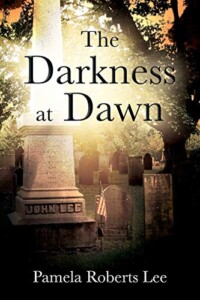Title: The Darkness at Dawn
Author: Pamela Roberts Lee
Publisher: Outskirts Press
ISBN: 978-1-9772-1285-6
Pages: 556
Genre: Historical Fiction
Reviewed by: Jason Lulos
Pacific Book Review
 When thinking of America’s early colonial days, from Roanoke to the Massachusetts Bay Colony, it’s hard to imagine what a stark reality those settlers must have faced. Harsh winters, primitive medicine/technology, and culture clashes with Native Americans, all combined to make life a rigorous struggle. Couple that with their extreme religious fervor including fear of witchcraft, and one must conclude that these people lived humble, desperate, passionate, and fascinating lives. In The Darkness at Dawn, author Pamela Roberts Lee vividly captures these lives with thorough research, engaging storytelling, and a gripping plot.
When thinking of America’s early colonial days, from Roanoke to the Massachusetts Bay Colony, it’s hard to imagine what a stark reality those settlers must have faced. Harsh winters, primitive medicine/technology, and culture clashes with Native Americans, all combined to make life a rigorous struggle. Couple that with their extreme religious fervor including fear of witchcraft, and one must conclude that these people lived humble, desperate, passionate, and fascinating lives. In The Darkness at Dawn, author Pamela Roberts Lee vividly captures these lives with thorough research, engaging storytelling, and a gripping plot.
It is a dark night in 1634 in the middle of the Atlantic. Hopeful passengers, bound for Massachusetts Bay, are seeking to create a City of God in the “New World.” Young John Lee, honest and savvy beyond his years, witnesses a crime during the storm at sea. The villainous Richard Hawkes makes a deal with John in order to hide his crime, inextricably linking their two lives for years to come. What follows is an epic, captivating tale about John’s life as he struggles with faith, war, and love in early colonial America.
John is honest to a fault, curious, and resourceful. He struggles with Puritanical doctrine but never loses faith in God and doing the right thing, even though there are times when he is filled with uncertainty. A renaissance man, John becomes an adept carpenter, farmer, soldier, constable, and teacher. Despite criticism from local religious leaders, John begins teaching Native Americans to facilitate better understanding and peace between the two respective cultures. John has plenty of obstacles in life, as many did during this relatively primitive time, but his ongoing feud with Richard Hawkes is perhaps the most constant struggle he faces.
This is a classic story of good versus evil. The author’s writing immerses the reader in the quaint yet gritty reality of the early colonial period. And even at a lengthy 556 pages, the plot is riveting. This speaks to the author’s talent as a storyteller but also, within the story itself, the calculating patience of Hawkes and the faithful patience of John.
This novel is inspired by author Pamela Roberts Lee’s own ancestor John, a real passenger on the Francis, who also has familial links with Nathan Hale and future princes Harry and William. With this notable family history and commendable research, the author paints a lush historical canvas behind a gripping story readers of history and historical fiction will love. I definitely recommend this one and look forward to the sequel, tentatively titled A Light at Midnight.


